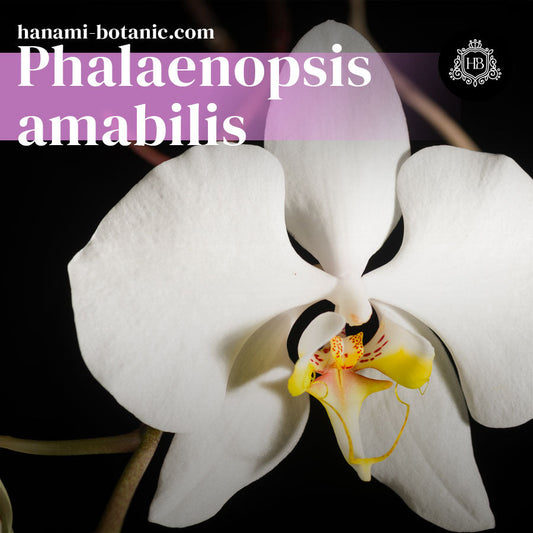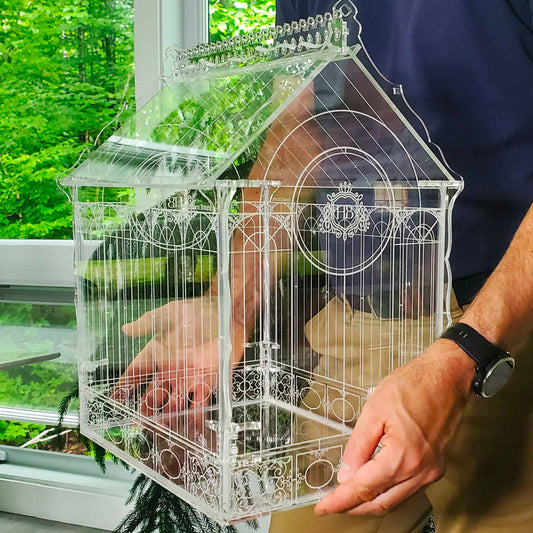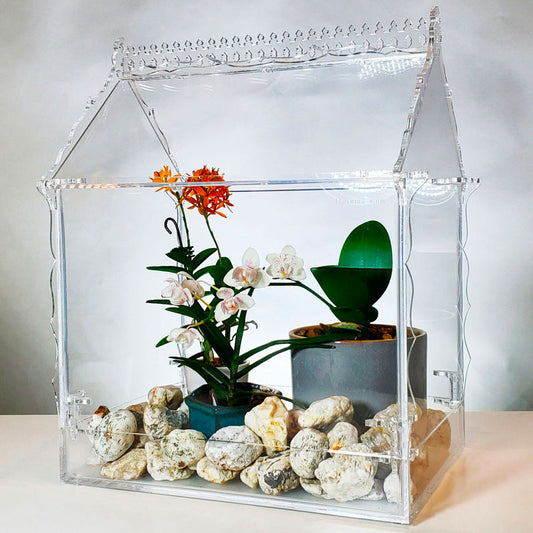Phalaenopsis amabilis - Moth Orchid
Christian St-PierrePhalaenopsis amabilis, also known as the Moth Orchid, is an elegant and refined orchid native to Southeast Asia.
Appreciated for its large white flowers and ease of cultivation, it is a favorite among orchid enthusiasts. What distinguishes this orchid is its ability to bloom several times a year, adding a touch of grace to any space.

Where to buy Phalaenopsis amabilis?Although this orchid can be challenging to find, it is sometimes available on specialized sites. You can check these sources to find Phalaenopsis amabilis:
Check these sites regularly to add this beautiful orchid to your collection. |
Origin and history
Phalaenopsis amabilis, also known as the Moth Orchid, originates from Southeast Asia, particularly the Philippines, Indonesia, and Malaysia.
This orchid is admired for its large, elegant white flowers and ease of cultivation, making it a favorite among orchid enthusiasts.
How to grow Phalaenopsis amabilis? Care guide
Quick Summary:
- Scientific Name and Family: Phalaenopsis amabilis, family Orchidaceae
- Plant Type: Epiphyte
- Light: Bright, indirect light
- Day and Night Temperature: 18-24°C during the day, 16-18°C at night
- Watering: Moderate, allowing the substrate to dry slightly between waterings
- Humidity: 50-70%
- Substrate: Mix of pine bark, sphagnum moss, and charcoal
- Fertilization: Monthly with a balanced fertilizer
- Growth: Moderate, with a resting period in winter

How to make Phalaenopsis amabilis bloom again?
To make Phalaenopsis amabilis bloom again, the difference in temperature between day and night is crucial. A drop of 5 to 10°C at night stimulates blooming.
Contrary to popular belief, it is not fertilization that triggers blooming, but it is essential for maintaining the overall health of the plant.
Bright, indirect light is also necessary to encourage flowering.
Varieties and similar plants
Explore other varieties of Phalaenopsis and similar orchids such as:
FAQ about Phalaenopsis amabilis
FAQ // Does one absolutely need an orchidarium or a Wardian case to grow a Paphiopedilum concolor?
Not necessarily, but using an orchidarium or Wardian case can greatly enhance the growth and blooming of Phalaenopsis amabilis. These controlled environments provide consistent humidity, stable temperatures, and optimal light, all of which are ideal for this orchid. However, you can still successfully grow Phalaenopsis amabilis without one by ensuring high humidity, maintaining temperatures between 70-80°F (21-27°C) during the day and no lower than 60°F (15°C) at night, and providing bright, indirect light. Good air circulation is also important.
For those who prefer a more modern touch, smart sensors can help monitor and adjust conditions. Alternatively, creating a DIY humidity dome or integrating your orchid into a terrarium setup with other plants can mimic the benefits of a Wardian case.
Feel free to check out our elegant Wardian cases at Hanami Botanic for a beautiful and functional addition to your home. Your feedback and suggestions are always welcome!
Discover my handcrafted Wardian Cases
FAQ // Is Phalaenopsis amabilis difficult to keep alive?
Phalaenopsis amabilis is relatively easy to keep alive, provided its needs for light, temperature, and humidity are met. Regular monitoring and appropriate care ensure healthy growth.
FAQ // How to care for a Phalaenopsis amabilis?
To care for a Phalaenopsis amabilis, provide it with bright, indirect light, maintain humidity at 50-70%, and use an appropriate substrate.
To achieve the desired humidity, you can use a humidifier, place a tray of water with pebbles under the plant, or grow your orchid in a closed space like a tabletop greenhouse, which retains moisture.
Water moderately and fertilize monthly with a balanced fertilizer.
FAQ // What kind of light does Phalaenopsis amabilis prefer?
Phalaenopsis amabilis thrives in bright, indirect light, ideally around 10,000 to 15,000 lux. Direct sunlight can be too intense and may scorch the leaves, so it's best to place this orchid near an east-facing window or a filtered south-facing window where it can receive gentle morning or afternoon light.
If natural light is limited, full-spectrum LED grow lights are a great alternative. Position the lights about 12-18 inches above the plant, providing 10,000 to 15,000 lux, and use a timer to ensure the orchid receives 12-14 hours of light per day.
Maintaining the right light levels will help your Phalaenopsis amabilis grow healthy and produce beautiful blooms.
FAQ // What is the best method for watering Phalaenopsis amabilis?

The best method for watering Phalaenopsis amabilis is to keep the roots moist but not waterlogged. Here are some effective techniques:
Phalaenopsis amabilis prefers a wet-dry cycle, where the roots are allowed to dry slightly between waterings. Water the orchid thoroughly when the top inch of the potting medium feels dry. Typically, this means watering about once a week, but frequency can vary based on environmental conditions. Be sure to use room temperature, distilled, or rainwater to avoid mineral buildup that can harm the roots.
Avoid letting the plant sit in water, as Phalaenopsis amabilis is prone to root rot. After watering, ensure the pot drains completely. A pot with good drainage holes and a well-draining orchid mix (such as bark or sphagnum moss) is essential.
For added humidity, you can place the orchid on a humidity tray filled with water and pebbles, ensuring the bottom of the pot does not touch the water directly. This helps maintain a humid environment around the plant, especially during dry seasons.
By following these watering methods, you can keep your Phalaenopsis amabilis healthy and thriving.
Detailed Care Guide for Phalaenopsis amabilis
Plant Type
Epiphyte, naturally grows on trees in humid environments.
Light
Bright, indirect light. Avoid direct sunlight to prevent leaf burn.
Temperature
Maintain a temperature of 18-24°C during the day and 16-18°C at night.
Watering
Water moderately, allowing the substrate to dry slightly between waterings. Too much water can cause root rot.
Humidity
This orchid prefers humidity levels of 50-70%. In my greenhouse, I use a humidifier to maintain optimal humidity levels.
Substrate
Use a mix of pine bark, sphagnum moss, and charcoal for good drainage and adequate aeration.
Fertilization
For Phalaenopsis amabilis, we use a specific orchid fertilizer, such as the MSU (Michigan State University) formula. This fertilizer is perfectly formulated to meet the nutritional needs of orchids.
- MSU Fertilizer: Provides an optimal balance of essential nutrients, promoting healthy growth and abundant flowering.
- Water pH: Maintain a pH of 5.5 to 6.5 for optimal nutrient absorption.
- Silicon: Strengthens plant cells, improving resistance to diseases and environmental stress.
- Fresh Seaweed: A natural source of micronutrients and phytohormones, stimulates growth and enhances root health.
- Superthrive: A vitamin supplement that helps reduce plant stress and stimulate growth.
- These products, when used together, create a nutritious and optimal environment for Phalaenopsis amabilis, ensuring vigorous growth and spectacular flowering.
Growth
Growth is moderate with a resting period in winter. Reduce watering during this period to allow the plant to rest.

I'm Christian. Passionate about orchids and terrariums for many years, I share my botanical adventures, practical advice, and personal anecdotes. I also create terrarium-style mini greenhouses to help your orchids thrive. Feel free to contact me—I’d be happy to help you on this beautiful botanical journey.
References
Conclusion
We hope this detailed guide on Phalaenopsis amabilis inspires you to enrich your orchid collection and explore the wonders of growing plants in a mini greenhouse.












